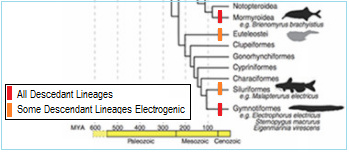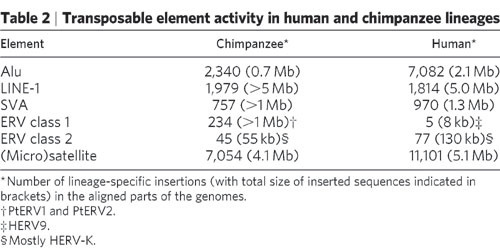hi bill.
i dont think that “evolved” is right term. i guess “created” will be more accurate since all the viral parts were already in the genome.
hi bill.
i dont think that “evolved” is right term. i guess “created” will be more accurate since all the viral parts were already in the genome.
Then whoever “created” them did a very strange thing, arranging them into phylogenic trees of common descent:
Paper reference: Phylogenetic Analysis Reveals That ERVs "Die Young" but HERV-H Is Unusually Conserved
But this is the case for many many parts of our genome that we look at. Here is another, an article on the main BL site:
Or this one also explaining nested hierarchies and exploring what are different ways to explain the data:
As @pevaquark states, this doesn’t explain why they form a phylogenetic tree.
It also doesn’t explain why you only get functional viruses when you take the mutations out of the ERVs. If ERVs are functioning as the source of viruses then they should be making viruses as they are.
If ERVs were the result of retroviral insertions in the past then they will have accumulated mutations over time, and removing those mutations will rescue their function as a virus. Scientists have actually tested this idea. They lined up several ERVs in order to find the mutations in those ERVs. When they removed those mutations they got a functional retrovirus that inserted with the same pattern as that seen in the human genome for that family of retrovirus:
“Human Endogenous Retroviruses are expected to be the remnants of ancestral infections of primates by active retroviruses that have thereafter been transmitted in a Mendelian fashion. Here, we derived in silico the sequence of the putative ancestral “progenitor” element of one of the most recently amplified family—the HERV-K family—and constructed it. This element, Phoenix, produces viral particles that disclose all of the structural and functional properties of a bona-fide retrovirus, can infect mammalian, including human, cells, and integrate with the exact signature of the presently found endogenous HERV-K progeny.”
reference
actually this is also true for evolution, since we have many cases of non-hierarchy. so if this is your criteria evolution is false too.
pattern of what? this case doesnt fit with evolution so they try to solve it by another theory.
we also know that a retrovirus can “steal” genes from the host.
think about a watch with a battery. we know that a watch without it will be non functional. so what make you think it will be different in rat case? do i realy need to show that such a watch cant be functional stepwise even by a designer?
maybe they did it in the past. we know now that many ervs parts are functional, so many of the non functional ervs may were the result of degeneration by a neutral mutation.
What are you talking about here outrigger? It’s clear you just ignored everything I’ve posted and have been posting. I have no idea what your tiny graph is about, unless you are still posting about that Yohn 2005 paper that definitely concludes that they are exogenous retroviruses, not endogenous retroviruses. You can’t just make something in microsoft paint and then somehow use it to prove what you are saying.
Here are some more nested ERVs:
If the red lines mark locations of ERV’s…
and there are 100,000 of them shared between chimp’s and gorilla …
and the 100,000 shared ERV’s are increasingly identical the more
recently they were shared…
Then what would you think was flawed about the case representing Common Descent?
Such as?
How does design explain those patterns of divergence between sequences?
That doesn’t change the fact that we can directly observe retroviruses creating new ERVs right in the lab.
Do you really think that there has never been a watch that doesn’t require batteries?
Yes, they were functional in the past when they were retroviruses inserting into the host genome.
i actually refer to this parts at the paper:
“This apparent independent clustering of retroviral insertions at similar locations may be a consequence of preferential integration bias or the effect of selection pressure against gene regions, limiting the number of effective sites that are tolerated for fixation.”
they indeed found in a similar regions in the genome. exogenous or not.
such as this case of non -hierarchy:
(image from here: How Evolution Gave Some Fish Their Electric Powers | WIRED)
again: we can also see the opposite.
I see. So we are back at the Yohn 2005 paper. You literally have ignored everything that we’ve ever posted to you and are still quoting this paper. 95.8% of the exogenous retroviruses occurred at different spots, leaving 4.2%. So you are now focusing on the 4.2% it seems and ignoring the other 95.8% that don’t have any similar insertion spots. And what are you trying to say here? That a small fraction of this data had preferential insertion spots? We know that this can be the case… but what this paper is saying… that I hope you will understand:
@outrigger ( @T_aquaticus & @pevaquark )
The image you posted is not a nested hierarchy (technically speaking, it is not a cladogram).
It is an illustration of the currently existing lineages… designed to show the lineages that
were sampled, and which branches were all “electrogenic” and which ones were not.
As you can see from a clarified image…
2 branches in the section I zoomed in on, only have “some” descendant lineages that are
electrogenic (key = orange). If it were a “Nested Hierarchy” illustration, they couldn’t have
portrayed it like this.

That looks like a nested hierarchy to me.
Also, analogous adaptations do not violate a nested hierarchy just as convergent evolution of bat wings and bird wings do not violate a nested hierarchy
The ERVs producing new retroviruses were put there by previous infections.
If I drew a picture of a rock floating in mid air would this falsify the theory of gravity?
Also, chimps and gorillas share a common ancestor so we would expect to find orthologous ERVs shared between the two species. We would also expect >99% of the orthologous ERVs shared by gorillas and chimps to also be shared by humans since all three species share the same ancestor. The only possible exceptions would be a handful of possible ERVs that were heterozygous in the common ancestor of all three species and could therefore be affected by incomplete lineage sorting. For comparison, there are several ERVs that are heterozygous in the current human population.
Which is a bit like organizing species by the ability to fly. Being able to produce an electric charge is an ability, not a physical feature.
Not sure if this is assent or dispute…
The image looks like a cladogram, but it is really just a summary listing of species groups.
I agree that it is a cladogram. I don’t see any need to argue over semantics.
All I was pointing to is that the ability to produce large electric shocks in water is not a morphological feature but is instead an ability like swimming or flying.
Replying to your post in another thread.

According to the first line of table 2 there are almost 5,000 differences in Alu alone, so how did you get to “Less than 400 of those 203,000 are different.”. I’m not a geneticist so you might have to explain that to me.
this is true if we assume that these are the result of viral infection. but if assume that all the 200,000 ervs are in the same spot because of preferential insertion spots then most of them have preferential spots.
i also explain that a retrovirus can be created from a genome genes.
what about the rat vs mice (sines) comparison here?:
@outrigger (& @pevaquark ),
We’ve already discussed a tidy journal article that found the “strength of preference” for a virus
choosing particular spot of DNA to invade was somewhere LESS THAN an additional 10% above
the a non-preference rate.
Less than an additional 10% is not going to get “all 200,000 ervs in the same spot”!
By mathematical definition, a preference as high as 10% (and it wasn’t that high in the article),
will only explain 20,000 of those ervs, leaving 180,000 in the same spot - - due to common descent
rather than preference.
“Let your conversation be always full of grace, seasoned with salt, so that you may know how to answer everyone.” -Colossians 4:6
This is a place for gracious dialogue about science and faith. Please read our FAQ/Guidelines before posting.